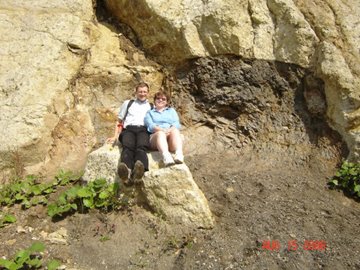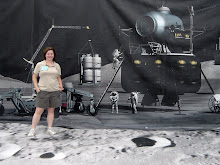I mentioned a while back on this blog that one of the highlights of my summer was going to be visiting the Ries Crater in southern Germany - and it was. Here's a photo of me with Walter Goetz, who's one of the investigators on the MER
Magnetic Properties Experiment. Walter joined me, Rob, and Gisela Poesges from the
Ries Crater Museum for 2 days of fun on the outcrops inside and outside the Ries. We were also joined on the second day by Iris Fleischer and a group of grad students from
the Mossbauer group in Mainz. It was super fantastic, really amazing to see the different kinds of ejecta so well preserved, we had tolerable weather except for one downpour, and Gisela knew all the best places to see shatter cones, the crater rim, megablocks, and lunch stops! Walter and I both got a lot out of the trip, trying to see impact products from the rover's point of view, and bringing back lots of samples for further study. Rob maybe didn't get so much out of the rocks, but Gisela did give him a chocolate model of the Ries Crater.

After Ries, Rob & I spent a couple of days in Krakow and western Poland checking out my family roots, then drove to Prague for the IAU meeting. It was a timely meeting to attend because it was where all the planet-definition discussion was heating up, culminating in
the vote that redefined Pluto. I couldn't vote, because I'm not a member of the IAU, so don't send me hate email. Honestly, I didn't think it would fly, because at a contentious lunchtime forum during the week, the panel asked for an informal show of hands and the proposals were soundly rejected. Basically, everyone is upset at different aspects of the proposal so there was no consensus. It's far from over and don't be surprised when the IAU takes this up again in 3 years at their next meeting.
(You're wondering how I would have voted? We now understand that Pluto is the prototype of this belt of icy objects in the outer solar system - it's a new discovery and reflects our new understanding of the solar system, and *that's* exciting. How to codify it scientifically seems less of a problem than dealing with the "public outrage." I did a radio interview last week on the topic and one of the other guests says he knows someone who learned the planets *before* there was Pluto. I wonder what that was like, did people protest that now all the textbooks were obsolete and how could they be expected to come up with a new mnemonic? Crazy.)




